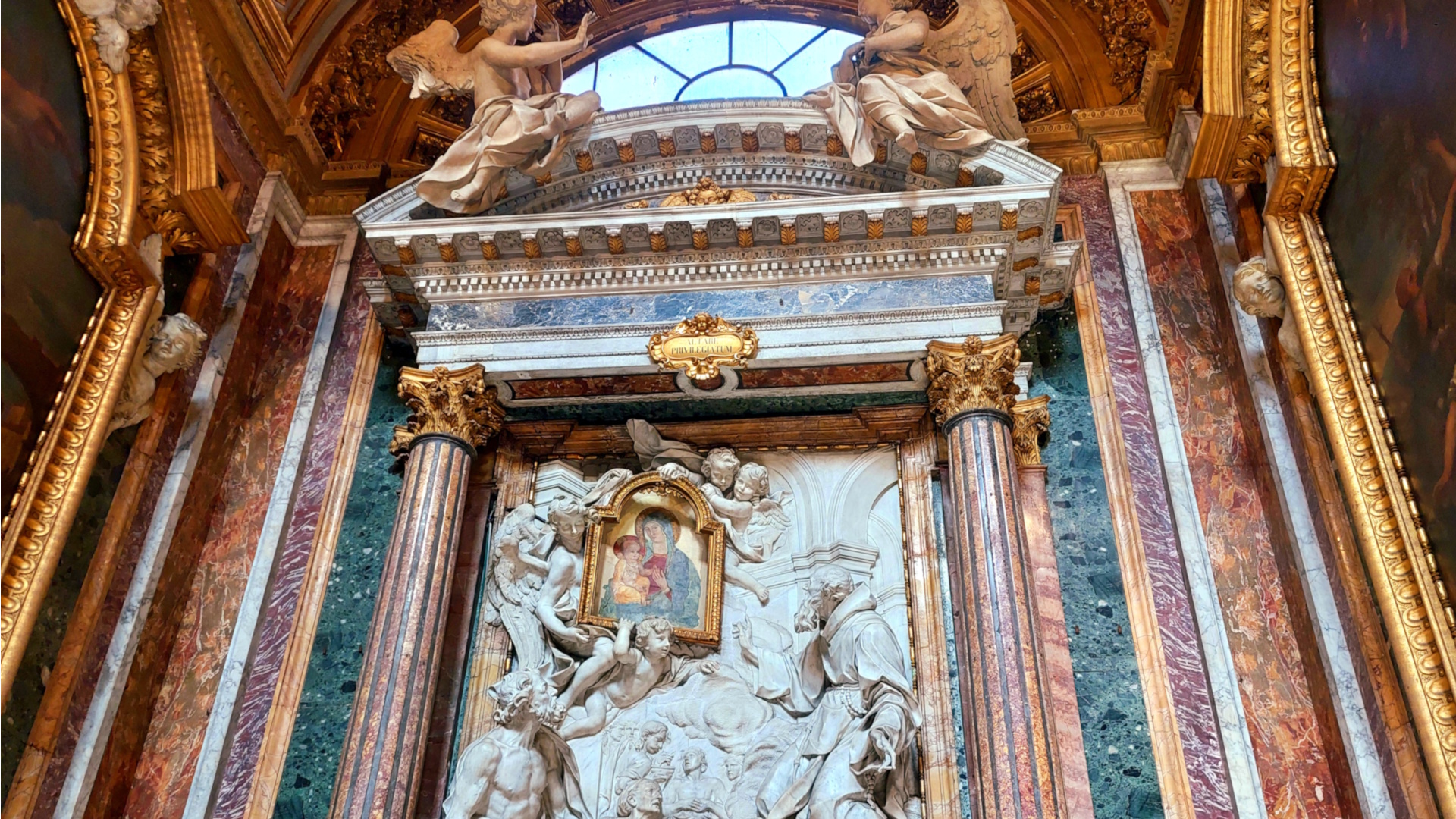
Art and spirituality between Renaissance and Baroque
From the hustle and bustle of one of the city’s busiest and most famous shopping streets to the tranquility of a beautiful church designed by Francesco da Volterra in 1592 and completed for the Jubilee of 1600 by Carlo Maderno, one of Rome’s most celebrated architects in the period of transition from the late Renaissance to the Baroque. The church overlooks Via del Corso and owes its name “in Augusta” to the remains of the nearby Mausoleum of Augustus, transformed into a fortress of the Colonna family in the 12th century, and reflects in its forms the artistic and liturgical canons of the Counter-Reformation sanctioned by the Council of Trent.
A hospital for the poor and the incurable
Ever since the Middle Ages, when the Colonna family built a small chapel dedicated to the Apostle James in this area, the history of the church has been inextricably linked to that of the adjoining hospital (no longer in operation), which was one of the oldest hospital in the city together with the Santo Spirito in Sassia and the Santissimo Salvatore ad Sancta Sanctorum. Soon to become known as San Giacomo degli Incurabili (incurables for the venereal diseases it treated), the hospital that still frames the façade of the church with its symmetrical arms was founded in the first half of the 14th century thanks to the conspicuous bequests of Cardinal Pietro Colonna. However, it played a fundamental role especially from the 16th century onwards, when plague epidemics and syphilis became real health emergencies. Its peripheral location, on the outskirts of the town, and the vegetable gardens and vineyards that dotted the area guaranteed its isolation and healthiness, while its strategic proximity to the Porta del Popolo, through which many pilgrims entered Rome, made it easily accessible and more functional. The bull of Leo X in 1519 that promoted it as the “Archiospedale degli incurabili” (hospital for the incurable) affirmed, among other things, the principle of free medical care. However, it was above all the activity of prominent religious figures of the time, such as St. Philip Neri, St. Cajetan and St. Camillus de Lellis (who had been treated in the hospital) that helped to reform the welfare organization to meet the needs of the whole community, especially the humbler classes.
A new church for the new hospital
One of the great benefactors of the new hospital was Antonio Maria Salviati: in addition to endowing it with a patrimonial fund and finally donating it to the city (with a perpetual restriction on its use as a hospital), the cardinal financed its enlargement with the architectural intervention of Francesco da Volterra. The architect was also commissioned to rebuild the church, which was then completed by Carlo Maderno, who worked on the upper part of the tall and harmonious façade, adorned with a recessed arched window with a scallop shell (symbol of the pilgrimage to the tomb of St. James at Compostela) and the coat of arms of Cardinal Salviati. By Maderno are also the two twin bell towers on either side of the sanctuary, a novelty in Rome. They are invisible from the street, and are perhaps best appreciated from the hospital’s inner courtyard and from some of the city’s vantage points, such as the Pincio. From inside the hospital one can also appreciate the grandiose volutes supporting the dome, a solution designed by Francesco da Volterra that anticipates the one used by Gian Lorenzo Bernini at Sant’Andrea al Quirinale. The church was sacked by a mob led by Angelo Brunetti in 1849 during the Roman Republic, and its interior fittings burned in a bonfire in the Piazza del Popolo. After papal power was restored, Pius IX commissioned and personally paid for a complete re-fitting of the church: between 1861 and 1863, under the guidance of Gaetano Morichini, the entire church was repainted and the vault was frescoed. Another intervention in 1912 affected the former baptistery, to the left of the entrance.
The works of art and Our Lady of Miracles
Majestic and richly furnished, the interior of the church has an elliptical plan with three chapels on each side and a dome that is also elliptical. Among the many works of art preserved inside are altarpieces by Giuseppe Passeri, Antiveduto Grammatica and Passignano, and a statue by mannerist sculptor Ippolito Buzzi depicting St James with a pilgrim’s staff and cloak. The impressive high altar placed in front of the entrance portal facing Via del Corso is also attributed to Carlo Maderno. Its four Corinthian columns in black and white veined marble Corinthian columns in black and white veined marble were allegedly plundered from the Mausoleum of Augustus. In the central chapel on the right (Chapel of Our Lady of Miracles), a spectacular 18th-century sculptural altarpiece by Pierre Le Gros frames a famous 15th-century wall painting depicting the Madonna and Child. This is the so-called “Madonna dei Miracoli”, the sacred image at the origin of the Church of Santa Maria dei Miracoli in Piazza del Popolo. In 1590, the image that was at the time kept in a small chapel along the river was in fact moved here to preserve it from the constant overflowing of the Tiber, and a copy was placed in its place in the chapel, which was later transferred to the church of Santa Maria dei Miracoli.
Informaciones
Mass times
Monday: 17.30Tuesday: 17.30Wednesday: 17.30Thursday: 17.30Friday: 17.30Saturday and public holidays: 17.30Sunday and public holidays: 08.30, 10.30, 17.30
Times may be subject to change, so please always contact the church
 Condividi
Condividi
Location
Para conocer todos los servicios de accesibilidad, visite la sección Roma accesible.











































